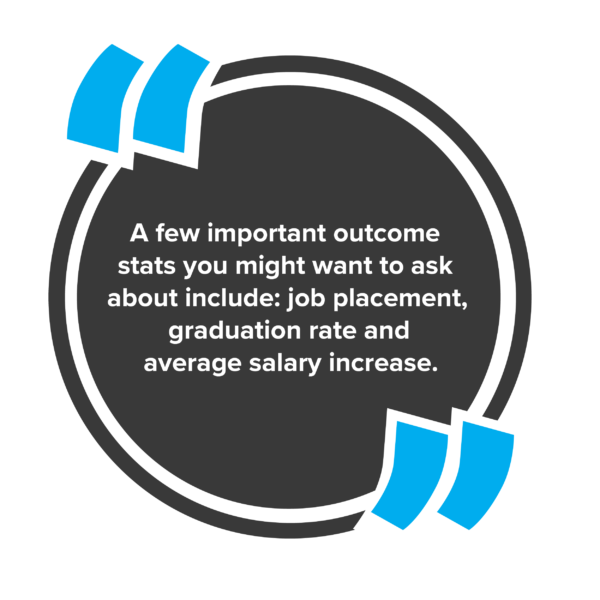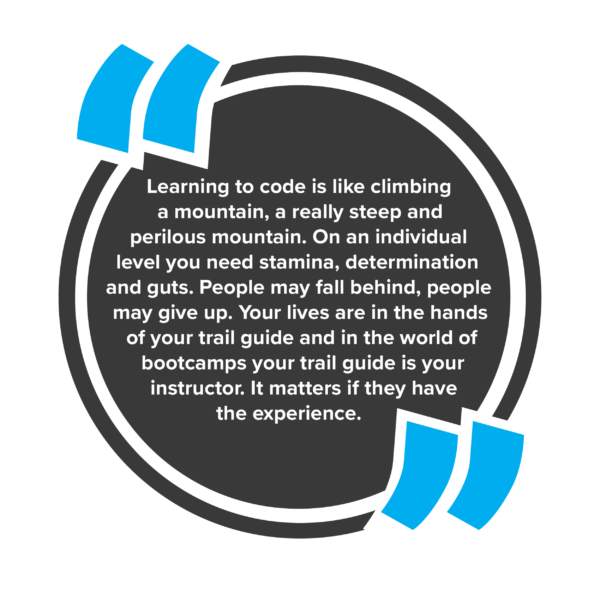How to Choose a Coding Bootcamp
A Framework to Evaluate Your Options
By Anthony Hughes, Tech Elevator Co-founder & CEO
As a bootcamp founder and industry watcher, I thought it would be helpful to offer a framework to help people think about which bootcamp makes the most sense for them. This framework focuses on how to approach choosing a bootcamp, and provides questions that I think are important for any prospective student to ask and have answered. As you take your time with your due diligence, I hope this guide will help you narrow your options and make the right decision for you.
Here are 8 questions to ask when you’re choosing a coding bootcamp:
1. WHAT ARE YOUR STANDARDS FOR ENTRY?
I agree with Steve Jobs who said “Everybody in this country should learn how to code because it teaches you how to think”. However, it’s important to add that not everyone is equipped to code professionally. And that’s ok. A quality bootcamp should be hard to get into. It’s a warning sign if it’s easy, because the field itself is not.
Entry standards matter because they determine who your peers will be in your class and by extension the depth and pace of your education. If a program has low entry standards, there will be a broader range of ability in your program. The wider the gap between the best and the worst, the harder it will be for your instructor to teach. Front runners will always be held back, stragglers will always be struggling and the instructor will be forced to teach to their level to keep them in the game. That just restricts the high performers. When you have a strong cohort of students you can move the pace faster and a peer to peer learning environment (a vital part of the bootcamp experience) can be optimized.
2. WHAT’S THE TOTAL PROGRAM COST AND DO YOU OFFER FINANCIAL SUPPORT?
Programs can range in cost from hundreds to tens of thousands of dollars. The best way to understand cost is to understand value – what kind of resources can you expect as a student in the program, do they include equipment, or is that extra (a good laptop should cost over $1000), and most importantly what’s the outcome? Real value comes from return on investment and that comes back to transparent placement outcomes.
A good bootcamp with local connections should also be able to defray some of your costs if they’ve been approved as a workforce training provider and if you fit certain eligibility criteria. Other programs may be able to assist through the GI Bill if you have a military background.
A few bootcamps, like Tech Elevator, have also been approved by Sallie Mae for student funding which is another mark of quality.
Another funding option is an Income Share Agreement or ISA. Income share agreements are students’ contracts with programs to pay a percentage of their future earnings for a fixed period after graduation in exchange for funds to pay for their education today.
At Tech Elevator we’ve always put our students first and we have been watching closely as the ISA funding model has become more prevalent throughout the coding bootcamp industry. While we believe in the promise of ISAs, we also have been cautious and diligent about offering them as a funding option in order to ensure that if and when we did offer them, they would be reflective of the student-first approach we take in everything we do. As part of the Stride family of companies, Tech Elevator is able to offer an ISA option directly to students with some of the most student-friendly terms in the industry.
(The ISA tuition plan is currently only available for Tech Elevator’s Full-Time Program. ISA plans are not available for residents of: Alabama, California, Colorado, Iowa, Illinois, Maine, New York, South Carolina, Washington D.C. or Washington. Read more information on Stride Funding’s Privacy Policy)

3. WHAT ARE YOUR STANDARDS FOR REPORTING OUTCOMES?
Make sure you understand specific coding bootcamp outcomes AND how they report those outcomes. A few important outcome stats you might want to ask about include: job placement, graduation rate and average salary increase. Many programs offer the appearance of transparency by self publishing their outcomes, often with many exemptions that allow them to “report” better results. The independent organization that audits and regularly reports coding bootcamp outcomes is the Council on Integrity in Results Reporting or CIRR. If a coding bootcamp doesn’t belong to it, and they aren’t transparent about how they report their numbers, it’s a red flag. By being part of CIRR, the coding bootcamp is committing to transparent outcomes reporting and adhering to a standard by which you can compare them to others.
On the financial note, it’s easy to be lured by the big salaries touted by bootcamps in big markets. Take the time to use a cost of living calculator to help compare salary levels if you’re considering various markets.
4. WHAT WILL I LEARN, AND WHAT’S ITS VALUE IN THE JOB MARKET?
There are a variety of languages you could start with learning. When researching bootcamps, make sure to dig into what they’re actually teaching. If your goal is to be a software developer, ask the bootcamp if they teach full-stack web development. You need both frontend and backend technologies in your foundation as a coder, so if they only focus on one specific area, that might limit your options and is something to consider. And if you have to take multiple courses to get to that foundation, factor that into your pricing comparison.
It’s also important to take the time to understand which technologies are in greatest demand in your area, and consider if that matches up with what you’d be learning. Since demand can vary greatly by geography, consider doing a survey of folks you know in tech asking: “if you were entering the field today, what would you learn?”
Understand that over their career, a software developer is likely to learn many different languages. That’s a sign of life-long learning characterized by great careers in tech. Taking a practical approach to language #1 with something mainstream will open up more opportunities on entry into the field.
5. HOW WILL YOU SUPPORT MY CAREER GOALS?
Coding bootcamps promise rewarding careers in tech jobs but not all programs are equal when it comes to helping their graduates secure their first job. Job assistance can range from cursory resume review sessions at the conclusion of a program to a fully developed system of support before, during and after the program. Choose a program that looks more like the latter. Research what’s involved in their “career assistance” and ask specific questions about the career development you’ll receive.
At Tech Elevator, a lot of our students credit our Pathway Career program with one of the most important aspects of the bootcamp experience. It runs parallel to the coding bootcamp and focuses on developing a person’s career readiness skills with sessions on elevator pitches, resume and interview prep, LinkedIn as a job search tool and networking. It follows graduation with 6 months of career support. Many students fall prey to the idea that technical prowess will trump everything. Unfortunately, more often than not, that’s not the case. At the end of the day, technical skills are important, but the best coder will fall short on securing a job against an average one 9 times out of 10 because of interview skills.
6. WHO DO YOU HAVE HIRING RELATIONSHIPS WITH?
The size and quality of a bootcamps hiring network can be a critical factor in securing your first developer role. Despite the strong demand for software developers in the economy, the first junior developer role is still the hardest job to secure. Bootcamps with an expansive network of established relationships can help you get past some of the initial resistance in the hiring process because of their track record of consistently delivering quality candidates. It’s ok to ask a bootcamp about the strength of their relationships, and where they have placed students. Additionally, take the time to research where alumni are working and reach out to them using LinkedIn. You’ll find they’ll be glad to describe what their experience was like. And they’ll usually be more candid than they might have been in a public forum like a review on Course Report.
Some bootcamps leave it entirely up to their students to secure their first opportunities after graduation. The result is often a protracted search lasting many many months. While it’s true that patience and tenacity are virtues that will serve anyone well in their career, it’s also true that putting newly acquired coding skills to work quickly following graduation can save a lot of financial and emotional stress. At Tech Elevator we believe in early exposure to hiring companies, through coaching and mentoring and pre-graduation interviews. As a result we’ve historically seen, on average, 35% or more of our students leaving with positions already secured at graduation, and for the remainder, great momentum going into the full blown job search.
7. WHAT’S THE BACKGROUND, EXPERIENCE AND PROFILE OF MY INSTRUCTOR?

Learning to code is like climbing a mountain, a really steep and perilous mountain. On an individual level you need stamina, determination and guts. People may fall behind, people may give up. Your lives are in the hands of your trail guide and in the world of bootcamps your trail guide is your instructor. It matters if they have the experience.
Coding bootcamps offer the promise of real world experience. That’s a huge differentiator from academic environments where tenured CS professors deliver curriculum that hasn’t changed in years. You need to hold your bootcamp to that promise. This is a huge investment for you, not just financially but in time and effort. Ask the bootcamp: Who will be my instructor? What have they accomplished? How long and diverse is their experience?
While it’s not uncommon to find former graduates of the program involved in the teaching process – usually in the form of Teaching Assistants or Academic Fellows there to get you unstuck on the basics – make sure that you will receive instruction from experienced developers.
Every employer will tell you that great developers are hard to find. More than that great developers with experience, empathy, emotional intelligence and an unwavering desire to help others on a journey to mastery, are a truly rare breed. At Tech Elevator, we constantly interview and evaluate instructor candidates and in most cases choose not to hire a candidate. We’re extremely picky because we know it matters more than anything to the student experience. There’s a small subset of developers in the market today who derive greater satisfaction from seeing others be great, than from being heralded as great themselves. For Tech Elevator, that’s the mark: be great, be humble, be a mentor and draw your energy from the success of others. That’s about the hardest employee to find.
8. WHAT’S YOUR INSTRUCTOR TO STUDENT RATIO?
It’s simple: a low instructor to student ratio means more one on one attention for the students and that’s important because everyone needs individual coaching when you consider the pace of a coding bootcamp. Some programs attempt to offset costs with extremely large class sizes which risks students getting lost in the crowd. For context, at Tech Elevator we aim to keep the ratio under 1:12.
Another thing to note is consistency in exposure and access to your instructors. Consistent exposure allows an instructor to get to know you, your strengths, weaknesses and your learning style. Without consistent exposure from experienced instructors it will be easier to fall behind without getting the help you need. A dedicated instructor team will go above and beyond to help you succeed. And that’s good for everyone.
What other factors are important to you? I’d be happy to answer any questions you have about comparing coding bootcamps, or Tech Elevator specifically. Feel free to shoot me a message at [email protected]. And good luck in your next career steps.
Our coding bootcamp has helped over 3,500 career changers learn to code and land fulfilling jobs in tech. We provide the highest quality learning and career prep experience delivered in both in-person and virtual classrooms.